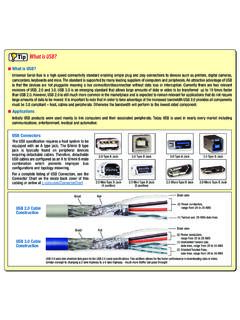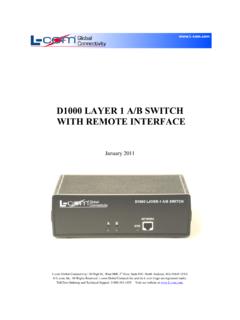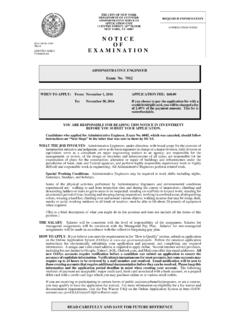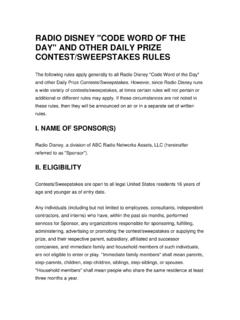Transcription of WiFi Antenna Installation Best Practices Design Guide
1 WiFi Antenna Installation Best Practices Design Guide 1 Choosing the right Antenna The first step to building a wireless network is choosing the correct Antenna for your application. Coverage and range will be the driving factors. Aesthetics may also be important. There are several styles of WiFi antennas with different radiation patterns, polarization schemes, and mounting options. Omni directional Antennas Omni directional antennas provide a 360o donut shaped radiation pattern to provide the widest possible signal coverage in indoor and outdoor wireless applications. An analogy for the radiation pattern would be how an un-shaded incandescent light bulb illuminates a room.
2 A high gain Omni s vertical radiation pattern will exhibit a flattened donut shape as shown below for the HG2415U-PRO Antenna . Typical applications for Omni directional antennas include indoor office spaces, retail stores, warehouses, small office or home networks, outdoor caf s, campgrounds, RV parks and marinas. Examples of Omni directional antennas include the common Rubber Duck found on many WiFi access points and routers as well as the complicated Antenna arrays used on cellular towers. Typical Omni directional Antenna radiation pattern (HG2415U-PRO) L-com, I nc.
3 A l l R i ghts R eserv ed. L-com C onnecti v i ty P roducts and the L-com L ogo are registered marks. T oll Free O rderi ng and T echni cal S upport: 1-800-343-1455 V isit our website at www. 2 In the example above an Omni directional Antenna is providing wireless connectivity for laptops, tablets, and smart phones in the coverage area. Directional Antennas A directional Antenna , as the name implies, focuses the wireless signal in a specific direction resulting in a limited coverage area. An analogy for the radiation pattern would be how a vehicle head light illuminates the road.
4 Examples of directional antennas include Yagi, Parabolic grid, patch, and panel Antenna styles. High gain directional antennas can transmit and receive wireless signals for several miles given clear line of sight and sufficient transmit power. (More on line of site on page 5). Applications for directional antennas include point to point wireless links connecting buildings, a back-haul data link connecting cell towers together and point to multi-point wireless links where multiple remote clients with directional antennas communicate with a single central tower with an Omni directional Antenna . Typical Directional Antenna Radiation Pattern (HG2424EG-NF) L-com, I nc.
5 A l l R i ghts R eserv ed. L-com C onnecti v i ty P roducts and the L-com L ogo are registered marks. T ol l F ree O rderi ng and T echni cal S upport: 1-800-343-1455 V isit our website at www. 3 In the example above building A and building B are set up for a directional, point to point network using Yagi antennas In this example both remote sites A and B have directional Wi-Fi connectivity to the base station fitted with an Omni directional Antenna . This is an example of a point to multi-point set up. L-com, I nc. A l l R i ghts R eserv ed.
6 L-com C onnecti v i ty P roducts and the L-com L ogo are registered marks. T ol l F ree O rderi ng and T echni cal S upport: 1-800-343-1455 V isit our website at www. 4 Antenna Polarity Polarization refers to the orientation of the electric field component of an electromagnetic wave with respect to the Earth s surface. An electromagnetic wave is composed of electric and magnetic fields propagating perpendicular to each other. Radio and light are examples of electromagnetic waves. Electromagnetic waves can propagate with linear, circular or elliptical polarization. Linear polarization is the most popular method used in WiFi communications and can take two forms, vertical and horizontal.
7 Polarity must be observed on both ends of a communication link. A properly designed Antenna will offer 20 dB or more of isolation between the two polarities. Dual Polarized Antennas A dual polarized Antenna uses extra internal elements to provide two polarities in a single package via separate input ports. For a linear Design both vertical and horizontal polarities are available. For a circular Design both right hand circular polarity (RHCP) and left hand circular polarity (LHCP) are available. The isolation between the two ports allows the Antenna to transmit or receive two signals on the same frequency simultaneously.
8 Dual polarity antennas have multiple uses. In outdoor multiple input-multiple output (MIMO) systems, the isolation allows the two MIMO streams to coexist without interference. For indoor systems, polarization or spatial diversity can counteract the effects of multipath and fading. In DBS home satellite systems, polarization is used to allow twice the amount of transponders to be installed on a satellite. Antenna Frequency Antennas operate at different frequencies to suit different applications. The antennas frequency must match the frequency of the amplifier, access point, or router it will be attached to in order for the system to work.
9 In the US the 900, 2400 and 5000 MHz frequency bands are set aside by the FCC for unlicensed Industrial, Scientific and Medical (ISM) applications. The lack of licensing requirements has greatly encouraged the growth of the wireless industry. These bands are used for consumer and commercial WiFi and WLAN applications as well as for commercial Radio Frequency Identification (RFID) and Supervisory Control and Data Acquisition (SCADA) applications. For the consumer the GHz band is the primary band one uses for WiFi, Bluetooth, cordless phone, printer, keyboard, mouse and gaming controller applications. Cellular use licensed bands spread over the 700 2700 MHz range.
10 L-com, I nc. A l l R i ghts R eserv ed. L-com C onnecti v i ty P roducts and the L-com L ogo are registered marks. T ol l F ree O rderi ng and T echni cal S upport: 1-800-343-1455 V isit our website at www. 5 Antenna Gain Gain is a relative measure of an antennas ability to direct or concentrate radio frequency energy in a particular direction or pattern. Gain is typically measured in dB over Isotropic point source, dBi. The analogy of an Isotropic point source would be a sun in the center of a universe. The choice of gain is dependent on system Design , coverage, range, and transmit power.
















